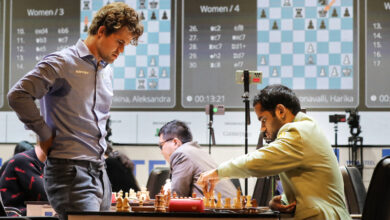IND vs WI 5th T20: Suryakumar Yadav shows he can play according to different situations | Cricket News

Rolled out under the shadow of the World Cup, every consequence, every cause and effect of this series would be weighed and assessed in the light of that tournament. It was predestined to serve one purpose — to polish India for the World Cup, to find solutions to persing problems. In this regard, they would be delighted with the touch and verve of Suryakumar Yadav, his response to different situations, his adaptability and maturity that shone through the most characteric T20 knock of his, one where Mr. 360 chose to be Mr. 180, one where the T20 destroyer morphed into a 50-over middle-overs manipulator.
He found himself in a classical middle-overs setting of an ODI, just five balls into a sluggish pitch, and losing partners regularly. He found himself in a place where most middle-order batsmen in T20Is find themselves in. Yashasvi Jaiswal tried to pull a not-so-short ball and ended up giving a return catch to left-arm spinner Akeal Hosein. He expected the ball to come at him slower, but it skidded on, as it does when spinners take the new ball. Hosein then undid Shubman Gill with the arm-ball on the sweep, though television replays showed that the ball would have missed the stumps.
So, Yadav was forewarned about the perils of the pull and the sweep. He lened, biting his ego, if at all he has one. He would then see a jumpy Sanju Samson edge one trying to steer the ball to third man. Hardik Pandya would heave and heave till he could heave no longer and ended up eating 18 balls for his 14 runs. None of it mattered to Yadav. He had identified the strokes he could summon on this pitch.
FIFTY for Suryakumar Yadav! 👏 👏
His 1⃣5⃣th T20I half-century 👌👌
Follow the match ▶️ https://t.co/YzoQnY6OpV#TeamIndia | #WIvIND pic.twitter.com/jsTWj95Eff
— BCCI (@BCCI) August 13, 2023
So, he had to anchor, accumulate and attack, ensure stability as well as a steady run rate. These are precisely the demands thrust on a middle-order batsmen in ODIs. Yadav mastered the situation as much as he did the bowlers, composing a knock more conventionally-etched rather than relying on his genius to improvise.
It was not just about the strokes, which in essence were semi-classical rather than new-age in rendition, but about the pace and mood of the knock. Unlike in the third T20, he did not counterpunch from the start. He had raced to 10 runs off three balls in that game, but here, he squeezed in just a four in his first 12 balls. The short and wide ball implored to be slapped through point, and he obliged emphatically. That was his method for much of the innings: he would calmly wait for the semi-loose balls, to which he could execute minimum-risk strokes.
Playing within himself
It’s the approach of the middle-overs sultans of the 50-over version. They don’t espouse a high-risk, low-percentage-stroke drill, but keep the run rate motoring along with singles and optimise the loose balls. Yadav usually whirls at a strike rate of 174, but here he operated at 135, still on the higher side, but not at the Yadav-level. He hits a boundary of every fourth ball he faces, here he managed one every eight balls. This doesn’t imply a struggle, but a batsman tailoring his game to the requirements of the pitch and situation. No one stuck with him — the highest partnership was 49 with a fluent Tilak Varma. One third of the runs came in a 19-run over from Alzarri Joseph. The extra pace on the ball helped, as did the Antiguan’s waywardness.
It was a pitch where sweeping spinners was difficult. Some balls would stop, some would skid on. Both Gill and Jaiswal were surprised the slipperiness of Hosein. So Yadav resed his most productive stroke against spinners, the sweep. He unfurled just one slog-sweep, a flat and straight one through long-on. Nothing was attempted behind square, even though both Hosein and Chase kept darting the ball into his body. The master of the inverted V scored most of his runs through the conventional V, or in front of the wicket. Apart from his first four, intersecting short third and backward point, none of his boundaries came behind square on either side. Not a single run was scored in the arc between third man and square-leg, for a monarch of the region. It was as though he wanted to burst perceptions and debunk myths spun around him.
India put up a fighting total after Suryakumar Yadav’s half-century 👊#WIvIND | 📝: https://t.co/siegjjubso pic.twitter.com/Z66bOC54k4
— ICC (@ICC) August 13, 2023
As his wagon-wheel would show, he attempted no scoops or ramps, or upper cuts or pulls. Once he tried to hook a slower-ball bouncer from the crafty Romario Shepherd, who grabbed four wickets, and missed altogether. Thereafter, he shelved the horizontal-bat shots altogether.
The team management’s brief to him was to face 45-50 balls in an innings. Albeit in a different format, he faced 44 and 45 balls apiece for his two fifties. Whereas it is no guarantee that his performances in the T2OIs would push his case for a middle-order berth in the ODI World Cup, he displayed his capacity to adjust to different conditions and circumstances, he demonstrated the varied layers of his batting, the different gears and scoring zones and patterns.
But with the tournament fast approaching, India desperately browsing for middle-order batsmen, recent form could matter. In this regard, there are positives to take home and smile about; none more valuable than the form of Yadav and his potential to solve India’s long-standing middle-order riddle.







